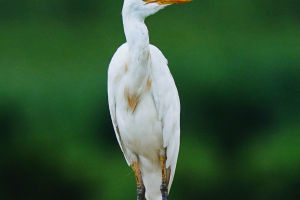Some blame the fictional Harry Potter and his snowy owl sidekick, Hedwig, for giving a false impression that owl care is easy or that owning one as a pet is acceptable. And while it can be quite common and enjoyable to have a pet parrot or another domestic bird, the same is not true for this wild bird of prey.
Snowy owls are typically solitary and aren't known to be affectionate toward each other or humans. Since they're most active at night and rely on sizable live prey as their main diet, they don't make a good pet. The snowy owl ranks up there with the most resplendent of all birds. With their white feathers, yellow eyes, and impressive wingspan, it is no surprise that they capture the imagination and attention wherever they go. Check out these astonishing facts about snowy owls.
1. Their Feathers Make Them Heavy
Snowy owls have an abundance of feathers to keep them warm, which adds to their weight of around 4 pounds. This thick feathering makes snowy owls the heaviest owl species in North America; they're a pound heavier than a great horned owl and double the weight of North America's tallest owl, the great gray owl. Female snowy owls are larger than males, as they're over 2 feet tall and have wingspans of up to 6 feet.
2. They Follow the Lemmings
While snowy owls eat a wide variety of small mammals and even other birds, their diet consists primarily of lemmings, particularly during the breeding season. An adult snowy owl can eat 1,600 lemmings a year. Because of this, their local numbers rise and fall with that of the lemming population. During times of lemming population booms, they can raise double or triple their usual brood.
3. They Store Their Food
During the breeding season, snowy owls create a cache of prey. Females store food the male has brought to the nest, generally in a wreath-like formation around the nest. Typically the stock is 10-15 items, but scientists have recorded as many as 83 carcasses. Additionally, males will create caches at separate perches with around 50 lemmings. These caches provide food during times when hunting is scanty.
4. They Are Not Night Owls
The expression "night owl" originated because of the nocturnal habits of most owls. However, snowy owls don't fit the mold. They aren't strictly nocturnal or diurnal. Their activity varies depending on location and the amount of sunlight. The type of prey available in the area also determines when the owl sleeps. This ability to hunt during the daylight is a good thing, since they breed in areas where the sun never sets.
5. Snowy Owls Don't Get Cold Feet
Snowy owls have feet and legs swathed in thick feathers, which provide the owls with insulation for the cold Arctic climate. They also have thick pads on the bottom of their feet. These feathers and pads act like snowshoes to prevent the owl from sinking into the snow. Sharp talons (claws) are used to grab prey.
What to do if you see a snowy owl:
Keep a safe distance to observe quietly.
Do not play bird calls from your phone or other device.
Don't feed the owls.
Avoid flashes when taking photos.
Keep noises to a minimum.
If you find an injured owl: contact your state wildlife agency or local rehabilitator.
If you find a dead owl: contact your local wildlife agency.


